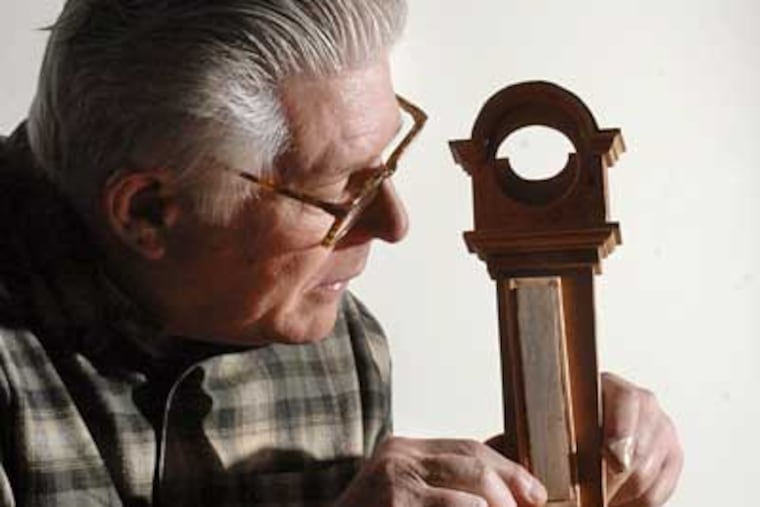A Chesco man spends his time making clocks
John Lawrence is convinced that genes tell, that talents and interests are passed down through families as certainly as body types and hair color.

John Lawrence is convinced that genes tell, that talents and interests are passed down through families as certainly as body types and hair color.
His Scottish grandfather made patterns for machine castings. His great-uncle crafted violins. His father was a Chester shipyard machinist who could make and fix anything, including clocks and watches.
Lawrence inherited a gift for fine manual work, which he exercised in his 32-year career as a dentist. Now semi-retired, he is applying those skills to his passion - making adaptations of some of the most beautiful clock designs ever produced.
"Everything runs in the family," he says. That principle applies not only to his own ancestors and relatives but also to the Willards, the most prominent American clockmaking family of the late 18th and early 19th centuries.
Lawrence's house in rural Kemblesville, Chester County, is alive with the ticking, striking and chiming of clocks - regal tall-case clocks, shelf clocks, lighthouse clocks, school and station clocks. In his living room alone, there are over a dozen clocks. Several were made by Lawrence in his basement workshop.
A man of many talents and interests, Lawrence, 63, constructed a fireplace in his basement out of used brick. He collects and restores antique cars. He merged his musical and mechanical genius by wiring an accordion to an upright piano. He exudes the relentless affability of a man accustomed to keeping patients relaxed and amused in a dental chair and the enthusiasm of a man for whom every day is a new chance to learn and invent.
In American clockmaking, the apogee, in Lawrence's estimation, is the period between 1785 and 1830, when clockmakers began enameling dials (they had been bare brass before), and cabinetmakers began making cases from mahogany in the Federal style, which reflected British influences and the architectural motifs of classical antiquity.
Simon Willard and his brother, Aaron, who lived and worked in Boston, were the supreme practitioners of the art. Although they made the movements only, they selected the finest cabinetmakers to complete or "case" their exquisite mechanisms. One of their clocks is in the Capitol, and they are prized by museums and collectors.
In 1999, Lawrence saw an especially fetching example of the Willards' work on the cover of a clock collectors' magazine. It was a tall-case clock with a Willard movement in a case made by the father-son team of John and Thomas Seymour, English cabinetmakers of exceptional skill who had gravitated to Boston after settling in Maine.
When Lawrence laid eyes on this horological masterpiece, he succumbed. "I have to have that," he said to himself. Since he couldn't afford to buy it, he had only one alternative: "I'll have to make it."
Using the tools he had at hand, and with no plans or diagrams, Lawrence set to work. It took three months just to saw and carve the fretwork, the fancy ornamentation atop the clock, after his wife, Joanne, an artist, helped lay out the pattern. She also numbered the clock face, ornamenting it with a rendering of their former Chester County farmhouse, as it appeared in 1820. The clock mechanism, or movement, came from Germany.
Lawrence spent a year making the clock, toiling at night and on weekends, learning as he went, exercising his imagination and resourcefulness. For instance, he roughed out the molding for the base with the tip of a chain saw and finished the shape with sandpaper wrapped around his wife's rolling pin.
Whatever impediments Lawrence encountered did not discourage him. Inspired by visits to museums, guided by photographs and other research, he has since tackled other Willard clock designs, including shelf clocks and lighthouse clocks, so named because they're perched atop a lighthouse-shaped base and enclosed in a glass bell.
Along the way, Lawrence has honed his skill in making cases, applying veneer and crafting intricate embellishments, such as lunette bands, so called because the repeating shapes inscribed in the molding resemble a crescent moon. He has learned to apply gold leaf, and to make the wood surfaces smooth and lustrous with a technique known as French polishing. To scorch the wood with distinctive designs, he uses the edges of hot pennies and nickels. To paint clock faces more easily and quickly, he fashioned a rotating table. In his basement, he can even forge small metal castings.
Lawrence is not afraid to experiment. He will change the shape and proportion of a clock to make it more pleasing to his eye. He will add or subtract decorations according to his personal aesthetic. His clocks are delightfully eclectic and irregular, which is to say they show endearing evidence, like their antique predecessors, of having been made by human hands rather than a machine. They have what Lawrence calls "the look and feel of age."
The components are expensive. The movements can range in price from $700 to $2,000. The finest come from a master craftsman, David Lindow, of Lake Ariel, near Scranton. The rare hardwood - mahogany, ebony, walnut, boxwood, rosewood - is not only costly but often difficult to obtain, especially with intriguing or spectacular grain.
Lawrence, who has made nearly a dozen clocks, began building them primarily for his own amusement. He has bestowed a few on friends and relatives (his son and daughter-in-law received his version of a Willard Massachusetts shelf clock on their first anniversary). Now, partly to help defray the cost of materials, Lawrence has decided to make clocks for sale, according to the design wishes of customers.
He does not expect to grow rich, or even to make a profit. That's not the point.
"I'd like to sell a few so I can keep on making them," he says.